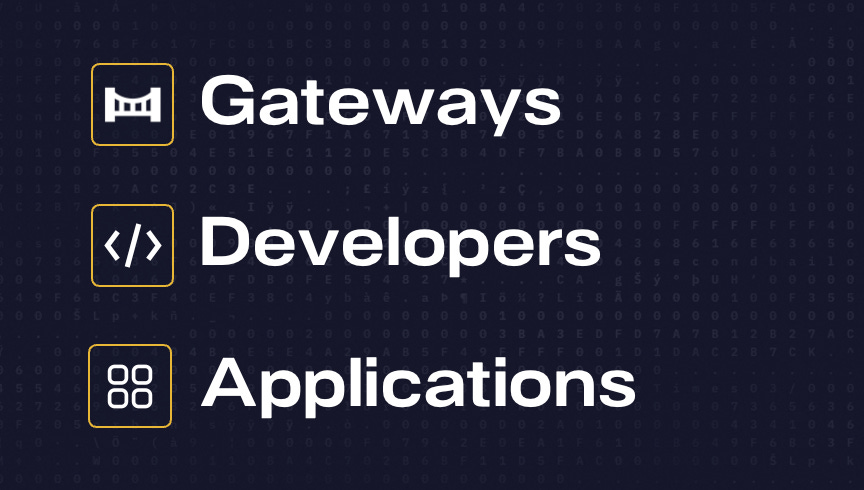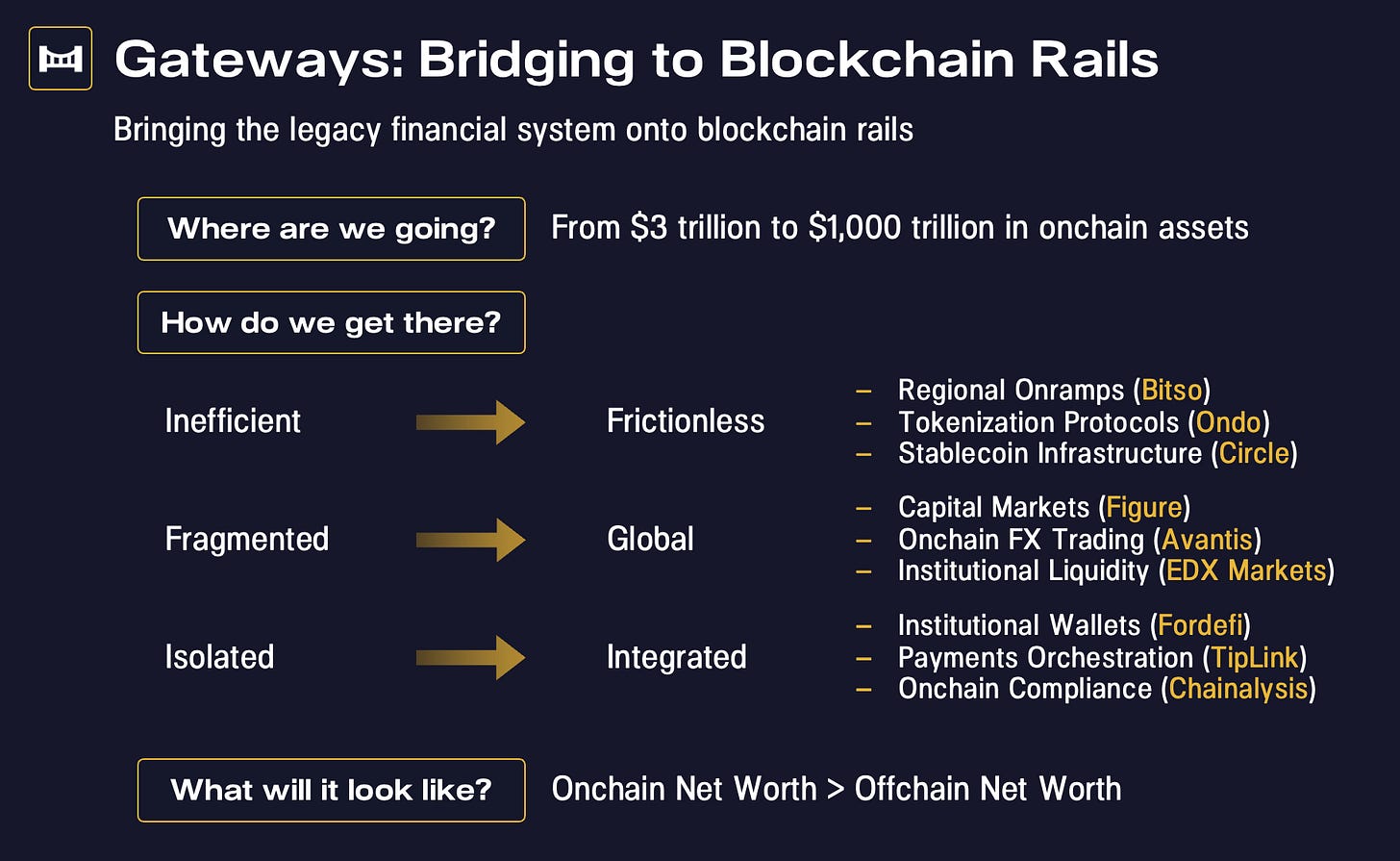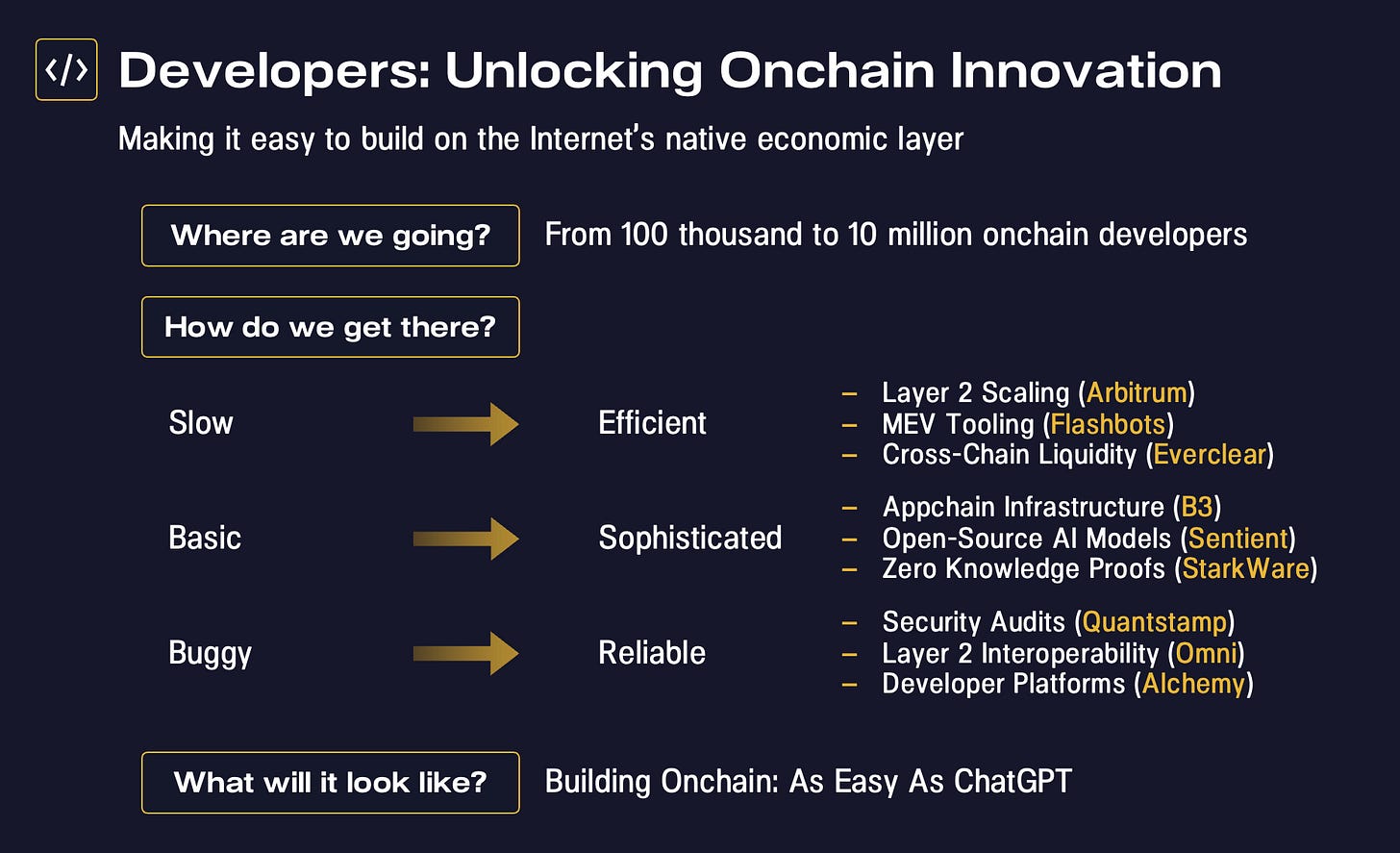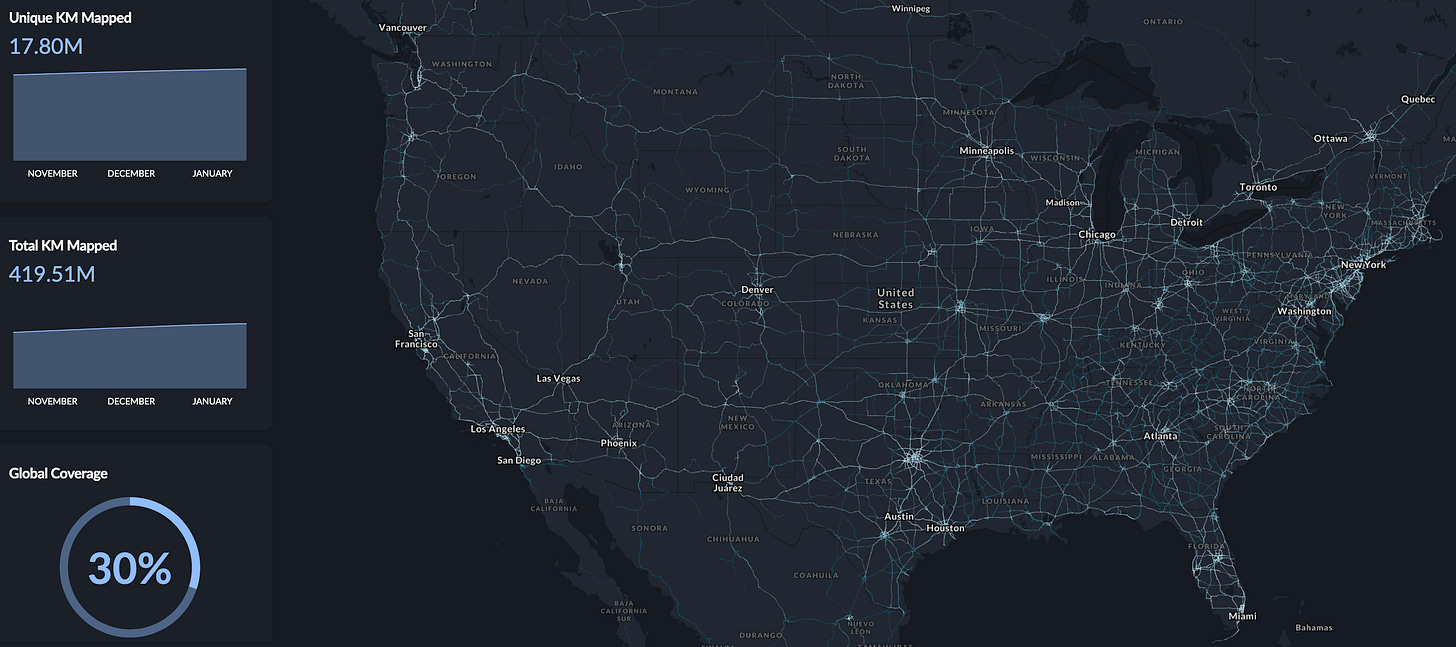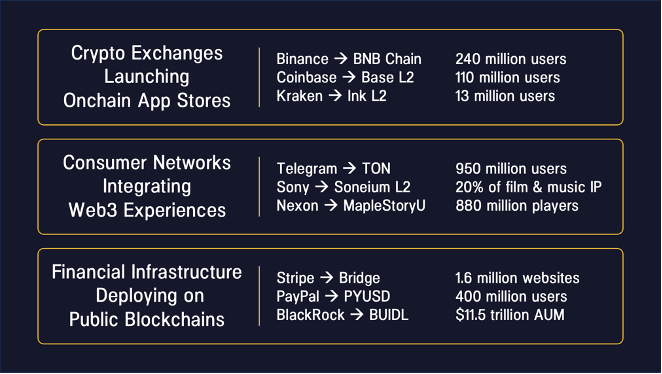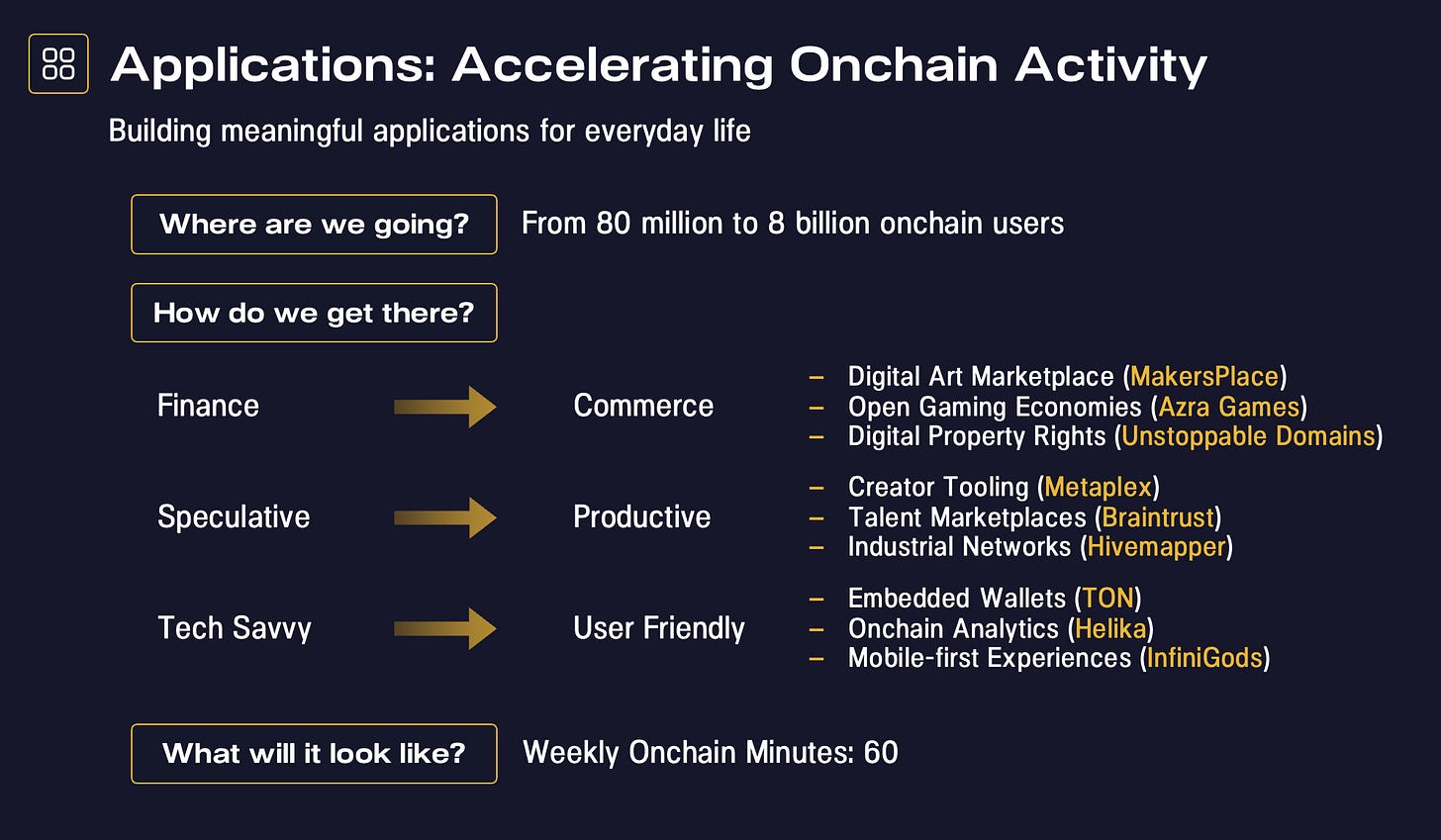The Path to Adoption
Finding the next 100x opportunity in crypto
What does the path to crypto's mainstream adoption look like?
When you look beyond the noise and speculation, that’s the only question that matters. As investors, our job is to map out the path to adoption because it's where we'll find the next 100x opportunity.
But the best venture investors don't predict the future. They see the present with great clarity. One thing is clear about the year ahead: 2025 will be a turning point for the crypto industry.
Imagine the state of the Internet if Jeff Bezos went to jail for online book sales.
If Steve Jobs were sanctioned for launching the App Store?
Or, if Jensen Huang was forced to build Nvidia outside of the US because Operation Chokepoint closed his bank account?That's the twilight zone that our industry is emerging from.
2025 marks the first time in blockchain's history that entrepreneurs, regulators, and policymakers can finally unblock the path to adoption.
Facing the now-open road, we return to our original question: What lies ahead on the path to adoption? Where will the biggest opportunities emerge—the next 100x or even 1,000x investment?
As "SoLoMo" (social / local / mobile) unlocked the Internet's potential in the 2010s, the convergence of three mega-trends will unlock crypto adoption from 2025 onwards:
Gateways: bringing the legacy financial system onto blockchain rails;
Developers: making it easy to build on the Internet’s native economic layer; and
Applications: building meaningful applications for everyday life onchain.
Gateways
Wall Street has undergone a 50-year-long software upgrade, from the introduction of electronic trading in the 1970s to the digitization of payments today. The steady, inevitable march of software eating finance has taught us one thing: All financial assets eventually migrate to wherever they can flow most freely, trade most efficiently, and command the highest value.
Today, blockchain networks secure $3 trillion in crypto assets (Bitcoin, Ethereum, etc.) and a small but mighty base of asset-backed tokens (tokenized dollars and Treasuries). The total financial assets held globally by households, governments, and corporations exceeds $1,000 trillion ($1 quadrillion!). That leaves 300x of potential growth still ahead of us.
Which inning are we in? The players haven’t even left the buses. The global balance sheet is now beginning its migration to blockchain rails. To succeed, we’ll need gateways that bridge us from the legacy financial system.
We must scale platforms that can effectively onboard new users and existing assets. Regional on-ramps like Bitso in Latin America are processing over 10% of US-Mexico remittances using blockchain. Tokenization platforms like Ondo are going head-to-head with Franklin Templeton and BlackRock to bring $20+ trillion of US Treasuries onchain.
Crypto is giving rise to the first truly global capital markets, enabled by real-time settlement and borderless liquidity. But global markets need global trading venues. Exchanges like Figure and Avantis are bringing together global supply and demand, while transforming markets in FX, credit, and securities.
Finally, we need products that work with existing systems, not just a parallel crypto universe. They may look like Fordefi's advanced wallet for institutions. Or, like TipLink's easy, grandma-friendly solution for sending payments.
What will it look like when we get there? We believe there will come a day when your net worth is worth more onchain than offchain. Once migrated onchain, your wealth can flow instantly across the world. It can trade cheaply without middleman fees and access global demand to achieve its highest value. That’s the point of no return.
Developers
There are ~100,000 developers building on blockchains today. That's one-half of a single Silicon Valley tech giant. To enable mainstream adoption, we need to increase that by 100 times and onboard 10 million developers.
Unlocking the creative potential of blockchain technology is paramount. Just as better tools for mobile developers unlocked the potential of Apple's App Store, we need tools that simplify building onchain apps and creating useful new products.
In 2025, the blockchain development stack will take a major leap forward. A crucial step depends on making blockchains themselves more developer-friendly. Scaling solutions like Arbitrum's optimistic rollup tech have created crypto's first "broadband moment." But, upgrades like Arbitrum Stylus may have a greater impact. Stylus enables developers to write smart contracts in multiple major programming languages like C, C++, and Rust, opening the door to over 10 million developers globally.
Zero-knowledge technology was once considered too intimidating for practical development. But, new tools like StarkWare's development kit are making zero-knowledge implementations easier than ever before. Today, zk-proofs are powering products like Freedom Tool, Rarimo’s blockchain-powered voting tool, already deployed in Russia, Georgia, and Iran to improve democratic participation.
The tools and infrastructure supporting blockchain development will play a vital role in driving progress. Platforms like Alchemy are helping developers to build and deploy onchain applications at scale. By streamlining the development process, Alchemy has already helped many projects achieve success, from decentralized finance (DeFi) protocols to gaming applications. As the blockchain ecosystem continues to evolve, it's imperative that these developer platforms keep pace, allowing developers to push the boundaries of what's possible onchain.
In 2025, the multichain universe will keep growing, likely at an accelerated pace. As developers face more complex challenges, new chains are emerging to tackle them, each with its own strengths and weaknesses in computation, execution, or decentralization. To cater to specific use cases like gaming or trading, application-specific infrastructure like B3 is taking shape. This explosion of chains, Layer 2s, and appchains demands seamless connectivity, which is where cross-chain liquidity solutions like Everclear and interoperability protocols like Omni come in – freeing developers to focus on building novel applications.
Web development has progressed from raw coding to intuitive no-code solutions, with AI now taking the wheel. We expect a similar evolution in blockchain development on the horizon. Each wave of technical advances and developer-focused tools will usher in a fresh wave of talent. Ultimately, building on-chain applications may become as simple as a conversation with ChatGPT.
Applications
How many people are onchain today?
By most estimates, the number is around 80 million onchain users. Much of that growth comes from crypto's appeal as "Wall Street 2.0" - a new place to raise capital, speculate, and send money. But expanding 100x to 8 billion people will depend on crypto's shift from Wall Street to Main Street.
2025 will likely be the tipping point for crypto's mainstream adoption. It will be a "FarmVille moment" for blockchain technology. FarmVille was Facebook's first social gaming hit. It drove the network's first exponential growth, turning it from a photo-sharing app into a global platform.
Crypto is accelerating toward its own "FarmVille moment." Onchain features are being integrated into new games and social applications. Gaming studios like InfiniGods are creating first-time onchain users. Their mobile casual game, King of Destiny, has already over 2 million app downloads over the past year, bringing people onchain who spend more time on Candy Crush than Coinbase.
Onchain gaming, social, and collectibles activity comprise ~50% of today's unique active wallets. As we onboard a diverse user base that engages in onchain commerce, it's clear that blockchains will disrupt more than just Wall Street.
A new class of "productive" apps is ushering in a new Industrial Revolution. The rise of corporations is giving way to the rise of Industrial Networks. Also known as DePINs, these applications focus on underserved markets in areas such as wireless connectivity, hyperlocal data, and human capital. They achieve this through on-chain coordination and market-driven mechanisms. Hivemapper is a decentralized mapping network that has mapped more than 30% of the world's roads, thanks to over 150,000 contributors, capable of more up-to-date and precise data than Google Maps.
Importantly, these “productive” applications are tapping into genuine revenue streams. In 2025, we believe the DePIN sector will exceed 2024's annualized revenue of $500 million. These industrial-grade cash flows provide a path to profitability based on real-world utility, setting up a strong commercial engine for new capital to flow into the onchain economy.
But how do we get these applications into the hands of 8 billion people? 2025 will see new distribution models that are capable of reaching hundreds of millions of consumers at scale. Crypto exchanges like Coinbase, Kraken, and Binance are creating their own chains to bring customers onchain. Telegram and Sony are incorporating Web3 features into their platforms with massive reach. Gaming companies are relaunching beloved games like MapleStory with onchain features, potentially converting millions of players. Institutions like PayPal and BlackRock are introducing onchain finance and payment solutions.
The convergence of these trends in 2025 will lead to a critical inflection point. When the average person has a reason to spend 60 minutes a week onchain, "being onchain" can become the new "being online.” Forget the “killer app.” Just as we swipe between apps on the Internet, people will have many reasons to spend time onchain. They may do it for fun, connection, or money. At that point, the onchain economy will be on pace to become a part of our everyday lives.
Looking Forward
The coming year will kick off an era where blockchain technology begins to blend into our daily lives, much like the Internet. The transition from Wall Street to Main Street isn't just happening — it's accelerating, driven by applications in entertainment, commerce, and practical utility.
In order to get there, we’ll need to invest in more accessible gateways, improved technology and developer tools, and applications that solve real-world problems. The path ahead of us in 2025 is still full of 100x opportunities, as crypto’s mainstream adoption becomes a reality. As a wise person once said: “The best way to predict the future is to create it.”



